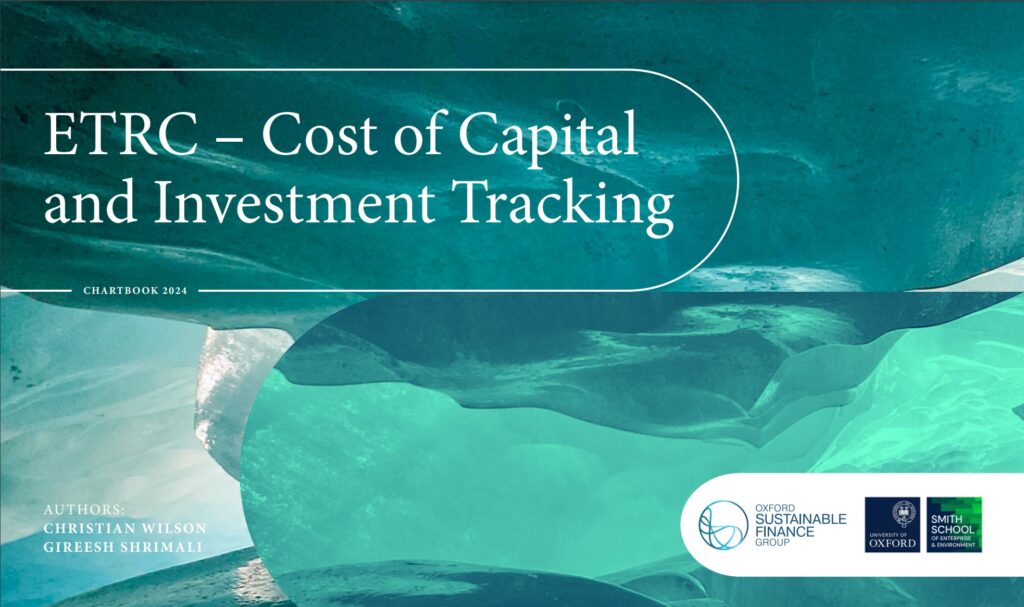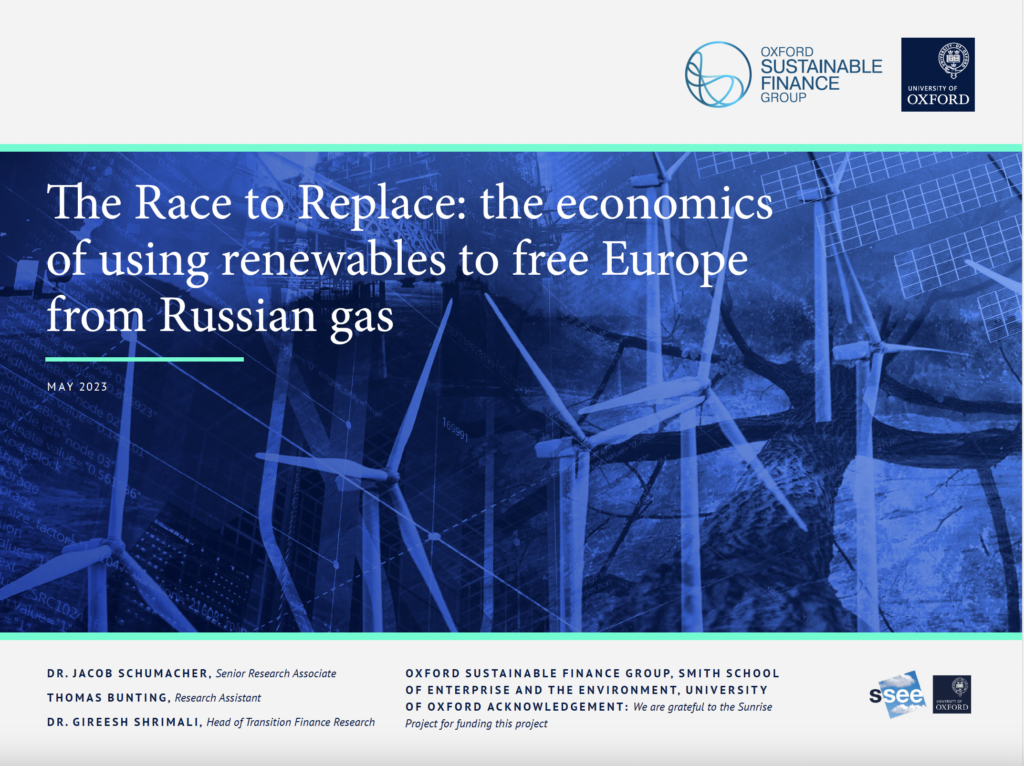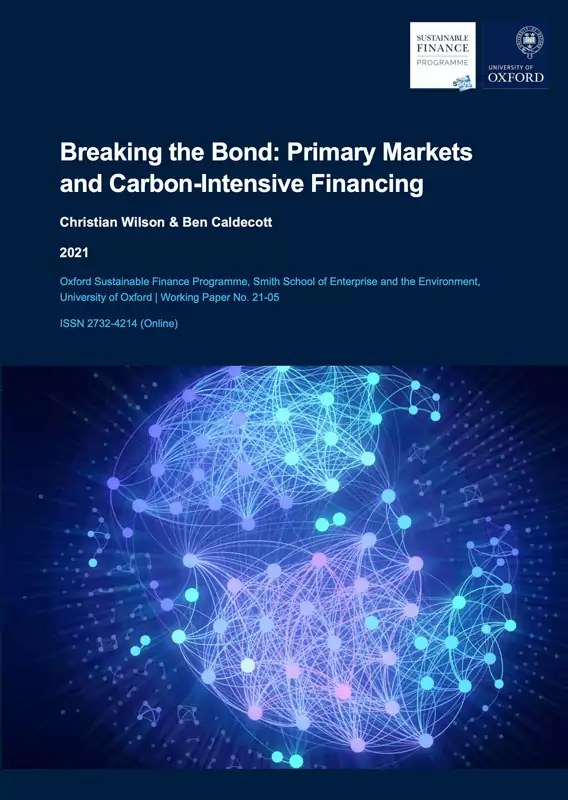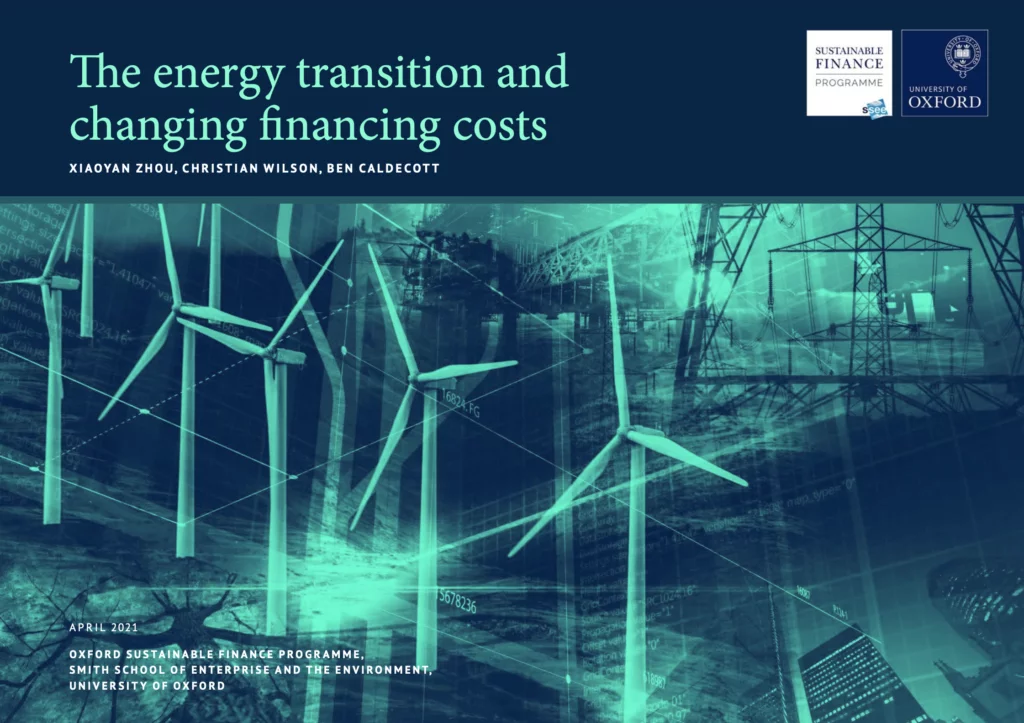Report publications
As economies and societies align with net zero, climate-related risks will arise through changes in policy, technology, and market preferences.
These transition risks will have implications for the cost of capital, investment decisions, and ultimately, the operations of companies.
ETRC, starting with the energy sector, and as part of the Oxford Sustainable Finance Group, will be undertaking research on these topics systematically over multiple years. Below are the latest ETRC publications.
A new report from the Oxford Sustainable Finance Group highlights that despite challenges the evidence shows the green energy transition continues at pace.
Higher costs of capital for renewables: In North America and Europe the cost of debt for renewables was 4 times higher in 2023 than in 2020, driven by increases in base interest rates. The biggest jump was seen in Western Europe, where the cost of debt for solar and wind grew from 1.4% to 6%.
Challenges remain: The report highlights that progress on the energy transition is happening despite the number of liquified natural gas assets under development steadily increasing.
Supportive policy, to keep the transition on track: The report highlights that the Inflation Reduction Act appears to have significantly increased low-carbon investment in North America.
A new report from the Oxford Sustainable Finance Group highlights that despite challenges the evidence shows the green energy transition continues at pace.
Higher costs of capital for renewables: In North America and Europe the cost of debt for renewables was 4 times higher in 2023 than in 2020, driven by increases in base interest rates. The biggest jump was seen in Western Europe, where the cost of debt for solar and wind grew from 1.4% to 6%.
Challenges remain: The report highlights that progress on the energy transition is happening despite the number of liquified natural gas assets under development steadily increasing.
Supportive policy, to keep the transition on track: The report highlights that the Inflation Reduction Act appears to have significantly increased low-carbon investment in North America.
Environmental Reputation Risk and the Cost of Equity: The Impact of Corporate Response to Climate Change Exposures
February 2025 | Authors: Xiaoyan Zhou, Rui Zhong, Gireesh Shrimali | Paper
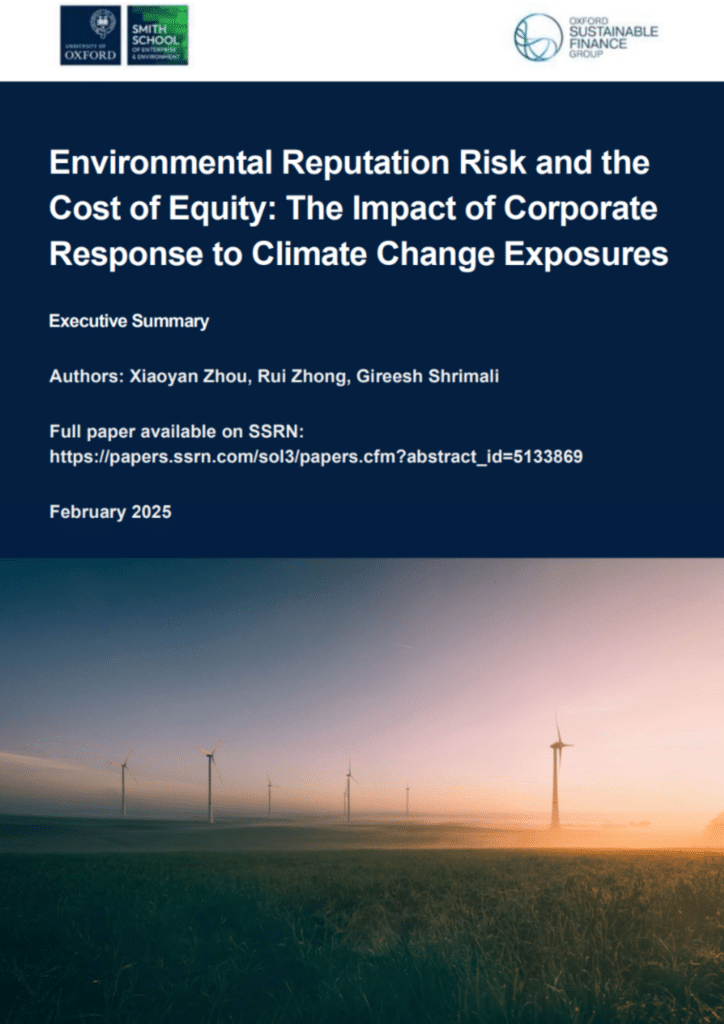
This study examines the impact of environmental and climate change reputation risk on the cost of equity, emphasising the role of financial analysts’ perceptions of corporate responses to climate change exposures. We find that reputational risk measured by environmental misconduct is positively associated with a higher cost of equity. However, firms that adopt a proactive approach to climate change-demonstrated by positive attitudes in earnings conference calls-experience lower equity costs following environmental misconduct. Conversely, negative corporate attitudes toward climate risks increase the equity costs of such incidents. The mediating effect of corporate attention on climate change exposures arises through its influence on analysts’ expectations of earnings forecasts. These results highlight the importance of proactive corporate engagement with environmental and climate risks in shaping investor perceptions and financial outcomes.
Financing costs and the competitiveness of renewable power
December 2024 | Christian Wilson, Gireesh Shrimali, Ben Caldecott | Paper
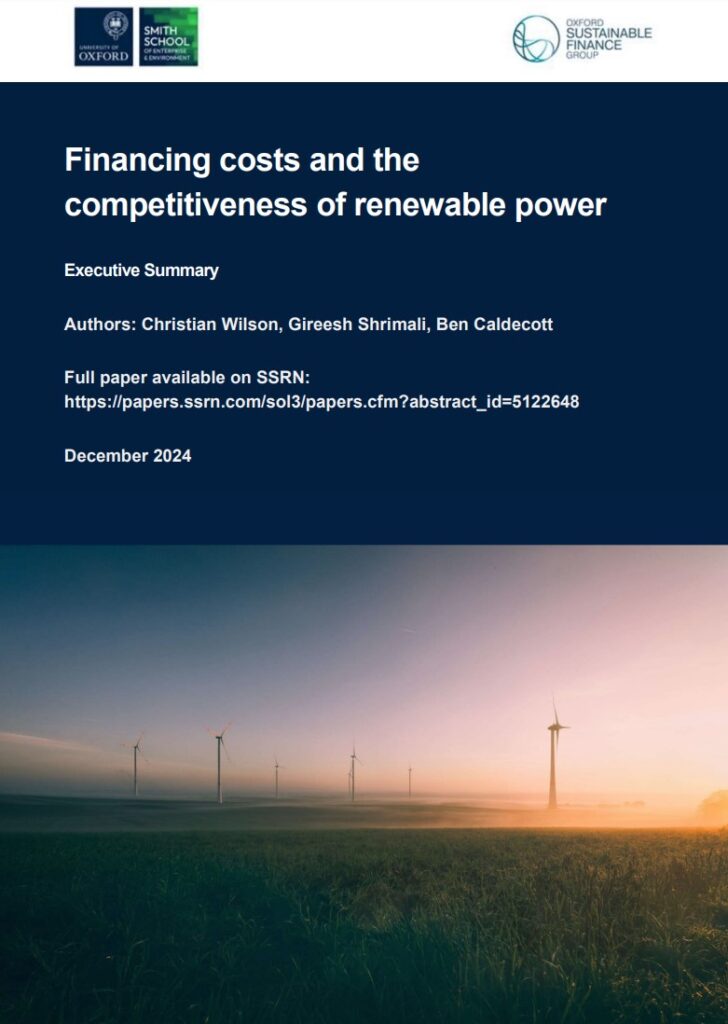
Relative to fossil fuel power, renewables are sensitive to changes in the cost of capital (CoC). After decades of low financing costs, interest rates have risen sharply in developed economies post-COVID19.
We investigate the implications of changing CoC on the competitiveness of renewables, with impacts differing by region. In the U.S., higher rates added 18% to the levelised cost of electricity (LCOE) of solar photovoltaics’ compared to 9% for combined cycle gas turbines.
However, with tax credits in the Inflation Reduction Act, solar LCOE increased by only 12%. In the future, falls in CoC will have little impact in Europe, given the high cost of fossil fuel power, but in the U.S., China, and India, differences in LCOE between certain renewable technologies and fossil fuels are minimised.
Consequently, falls in interest rates or targeted policy interventions that reduce the CoC of renewables can facilitate cost parity with fossil fuels.
We study whether net zero transition (NZT) affects loan pricing in the energy and utilities sectors of the loan market. We find that firms with higher levels of overall NZT disclosure experience lower cost of debt in the loan market, controlling for loan-specific and firm financial characteristics. This association is much more pronounced in Europe than in North America and other emerging markets. We also identify relevant NZT actions contributing to such a relation. Firms disclosing clear emission reduction targets which align with the Paris Agreement enjoy lower loan spreads. Additionally, environmental R&D expenditure and improved energy efficiency policies are associated with lower loan spreads. Moreover, effective governance actions, such as environmental management training and ESG-linked executive compensation, reduce climate risks and loan spreads.
See Full Report
Investment by Oil & Gas Firms in High- and Low-Carbon Energy: The Effect of Energy-Related Uncertainty and Climate Policy
2 May 2024 | Christian Wilson, Gireesh Shrimali, Ben Caldecott | working Paper
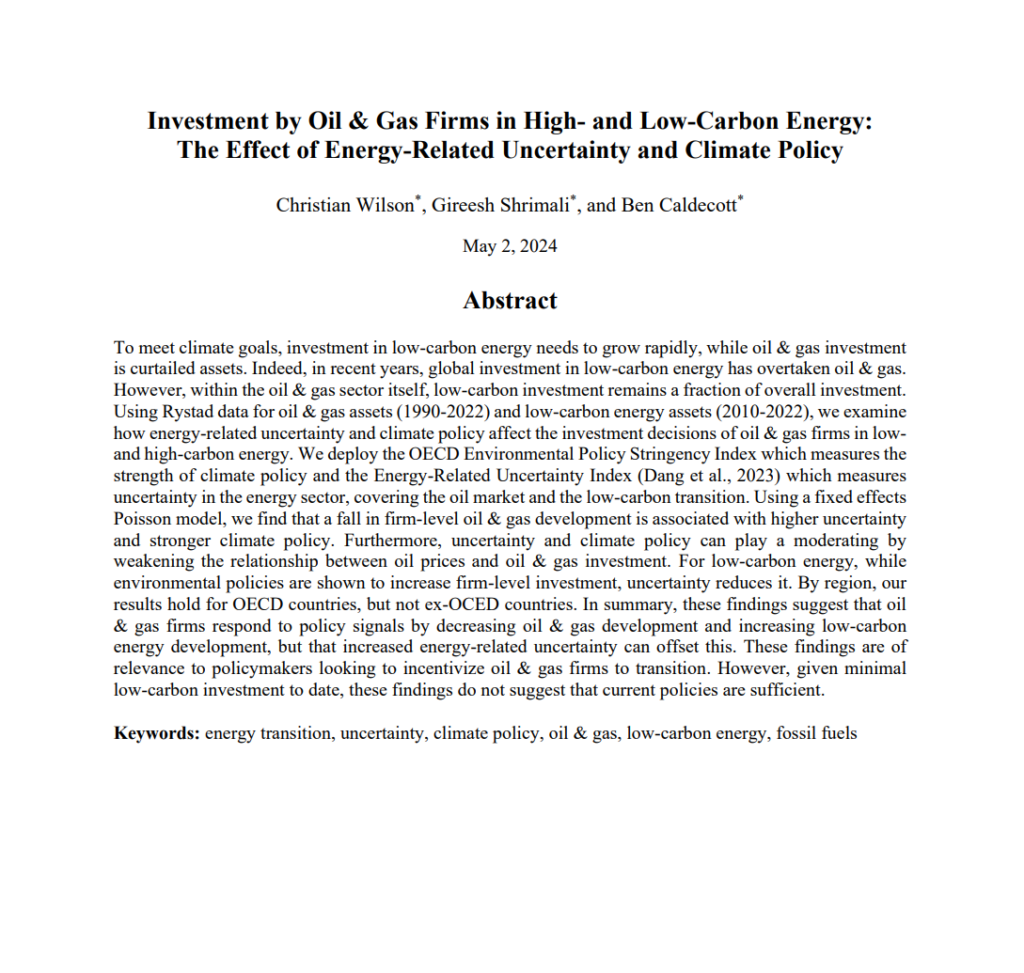
To meet climate goals, investment in low-carbon energy needs to grow rapidly, while oil & gas investment is curtailed assets. Indeed, in recent years, global investment in low-carbon energy has overtaken oil & gas. However, within the oil & gas sector itself, low-carbon investment remains a fraction of overall investment.
See Full Paper
The EU can replace Russian natural gas with green technologies by 2028, finds a new report from the Oxford Sustainable Finance Group, part of the Smith School of Enterprise and the Environment at the University of Oxford. It estimates that up to 90% of the additional investment required, on top of currently planned European Green Deal spending, could be recouped over the next thirty years by eliminating the need to buy gas.
In response to Russia’s illegal invasion of Ukraine, the EU has implemented emergency measures (RePowerEU) to eliminate its reliance on Russia as a source of natural gas by 2028. The new analysis investigates the cost of fully replacing this gas for electricity and heating with clean energy, rather than substituting supply with fossil fuels from other countries.
Given that Russian gas accounted for approximately half of the EU’s natural gas supply in 2021, this would have a significant positive impact on energy security and decarbonisation, say the authors.
“The transition from Russian gas to clean energy is not only achievable, but offers multiple benefits. Replacing natural gas with wind and solar energy eliminates the need to pay for gas in future,” says Dr Gireesh Shrimali, co-author of the report and Head of Transition Finance Research at the Oxford Sustainable Finance Group.
“By eliminating reliance on importing a fossil fuel with volatile prices and supply, the EU can alleviate energy security concerns, address the cost-of-living crisis through energy costs, and advance its goals to achieve net zero emissions and tackle the climate crisis.”
The report proposes policy changes needed to enable this transition. Crucially, public and private funds must be available to achieve large-scale deployment of renewables and heat pumps. The authors also suggest targeted policy support for investors, including through improved auctions for utility-scale solar and wind and addressing permitting challenges, deploying rooftop solar panels at speed, and increasing support for insulation and the installation of heat pumps.
See Full Report
Drivers of Firm Investment in Low and High-Carbon Energy: Capital Markets and Climate Policy
14 April 2023 | Christian Wilson, Gireesh Shrimali, Ben Caldecott | working Paper
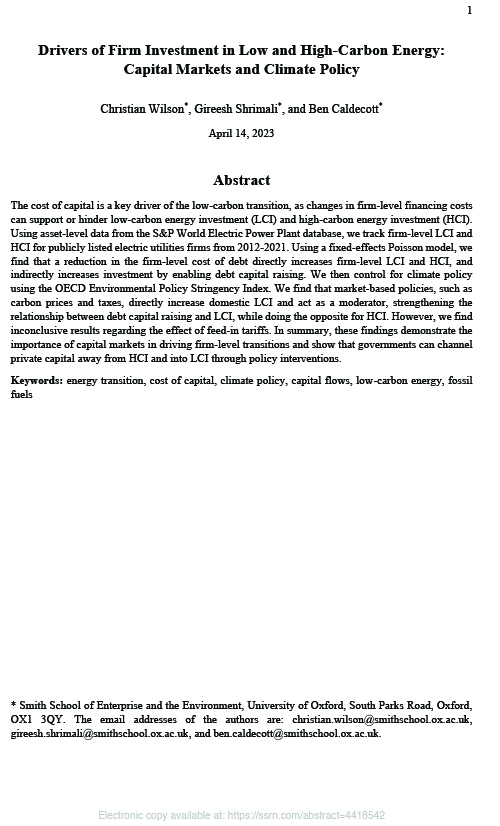
The cost of capital is a key driver of the low-carbon transition, as changes in firm-level financing costs can support or hinder low-carbon energy investment (LCI) and high-carbon energy investment (HCI). Using asset-level data from the S&P World Electric Power Plant database, we track firm-level LCI and HCI for publicly listed electric utilities firms from 2012-2021.
See Full Paper
An Empirical Analysis of Climate and Environmental Policy Risk, the Cost of Debt and Financial Institutions' Risk Preferences
31 March 2023 | Xiaoyan Zhou, Ben Caldecott, Gireesh Shrimali | working paper
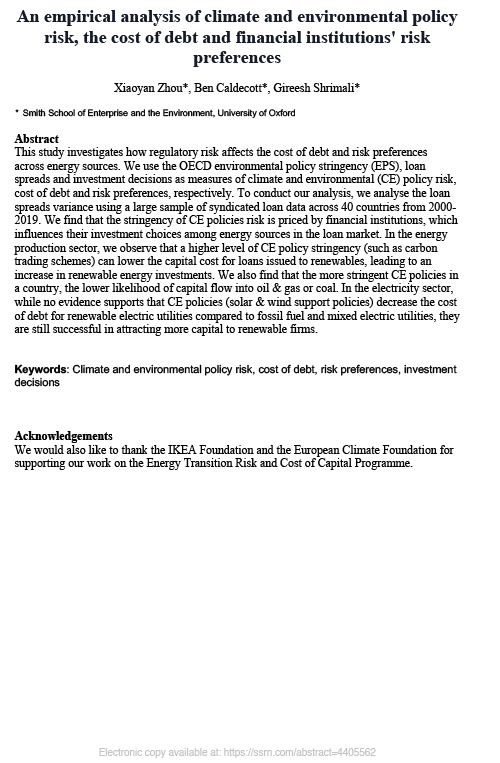
This study investigates how regulatory risk affects the cost of debt and risk preferences across energy sources. We use the OECD environmental policy stringency (EPS), loan spreads and investment decisions as measures of climate and environmental (CE) policy risk, cost of debt and risk preferences, respectively.
See Full Report
Energy Transition and the Changing Cost of Capital: 2023 Review
February 2023 | Xiaoyan Zhou, Christian Wilson, Anthony Limburg, Gireesh Shrimali, Ben Caldecott | Report
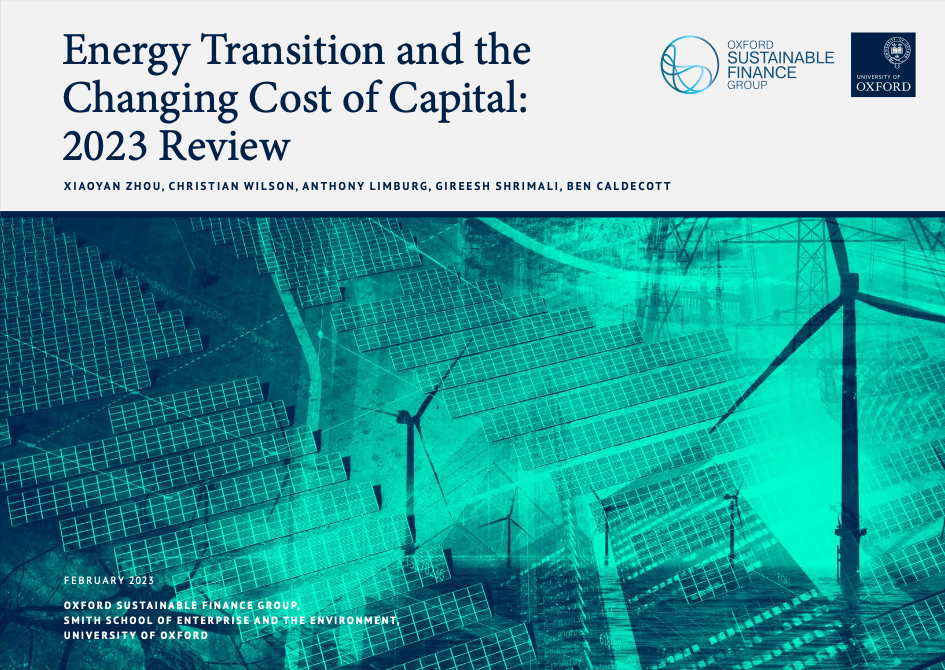
Our 2023 report extends the scope of analysis to the cost of equity as well as expanding our analysis of the cost of debt. In this process, we looked at corporate bonds and included data from other sources, including the Platts World Electric Power Plants Database (WEPP) and the Institutional Brokers’ Estimate System (IBES). We tracked the cost of capital across the global energy system in both electric utilities (renewable and fossil fuel) and energy production (oil & gas, coal mining, and renewable fuels & technology).
See Full Report
Financial institutions with over $70 trillion in assets have so far pledged to achieve net zero portfolios and loanbooks by 2050, including meeting ambitious interim 2030 targets. This working paper reveals that passive corporate bond funds not only hold fossil fuel assets, but directly finance them by buying large quantities of new bonds issued by fossil fuel companies. To track and manage transactions that are channeling capital flows directly into fossil fuels, the authors propose a new metric, Primary Market Carbon Exposure (PMCE). PMCE measures the proportion of securities bought in primary market transactions, for example shares at IPO or new bond issuance, from fossil fuel companies. They find that between 2015 – 2020, 14% of the value of new bond issues bought by U.S. corporate bond Exchange Traded Funds (ETFs) were in fossil fuels.
This report seeks to understand how the cost of debt across different energy technologies and markets has changed over the last twenty years. It forms the first output of the Energy Transition Risk and Cost of Capital Project (ETRC). While climate-related transition risks in the energy sector are sometimes viewed as distant, long-term risks, the impacts of which will not be felt for decades to come, we find this does not reflect reality.
See Full Report

